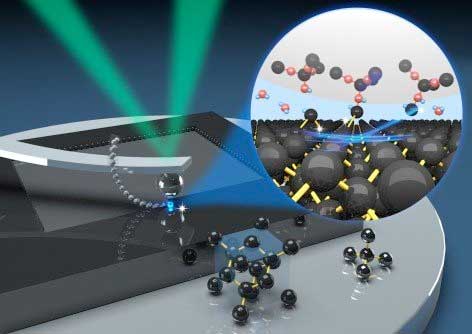| Posted: Apr 23, 2018 |
A simple method etches patterns at the atomic scale
(Nanowerk News) A precise chemical-free method for etching nanoscale features on silicon wafers has been developed by a team from Penn State and Southwest Jiaotong University and Tsinghua University in China (Nature Communications, "Nanomanufacturing of Silicon Surface With a Single Atomic Layer Precision Via Mechanochemical Reactions").
|
|
In standard lithography, a photosensitive film is deposited on a silicon wafer and a pattern called a mask is used to expose the film. Then, chemicals, such as KOH solutions, etch patterns into the silicon. Further steps are required to smooth out the roughened surface.
|
|
The researchers at Penn State and Southwest Jiaotong University developed an entirely different, chemical- and mask-free one-step process. They lightly rub a rounded silica tip of an instrument called a scanning probe microscope across a silicon substrate – the material typically used to make electronic devices. When exposed to the water vapor in air, the top layer of silicon forms bonds with the tip of the scanning probe and a single layer of atoms slides off as the probe moves across the silicon. Because the atoms below do not take part in the chemical reaction, they are completely undamaged.
|
 |
| A single layer of silicon atoms (black) bind to the moving silica tip of a scanning probe microscope. (Image: Lei Chen/Southwest Jiaotong University)
|
|
“It’s really quite a unique idea,” said Seong Kim, professor of chemical engineering, Penn State. “It’s a so-called tribochemical reaction. Unlike chemical reactions caused by heat, light or electric fields, which are all widely studied, mechanically-stimulated chemical reactions are less understood.”
|
|
The removal mechanism is initiated when the silicon is exposed to air and the top atomic layer of silicon atoms reacts with water molecules to make silicon-oxygen-hydrogen bonds. Then the silicon oxide surface of the tip forms a silicon-oxide-silicon bond with the substrate surface under the shear force of the moving tip. This facilitates the removal of the silicon atom from the topmost surface of the substrate.
|
|
People in nanofabrication who are trying to reduce the size of device features down to atomic scale dimensions could find this technique useful, Kim believes. “Atomic layer etching can provide the depth resolution that people would like to get without the use of sacrificial layers and harsh chemicals,” he said.
|
|
This kind of patterning method is too slow for microfabrication now, Kim acknowledges. However, researchers could use it to create a platform for testing electronic and microelectromechanical devices with features at the Angstrom or single atom scale, far smaller than current devices. At least one company, IBM, has experimented with multiple probe arrays that could lead to large-scale patterning of devices.
|
|
“Our process could be combined with their process to scale up,” Kim said. “This is the initial science part. Once we see the science, a lot of possibilities can be explored. For instance, we think this technique will work with other materials beyond silicon.”
|

